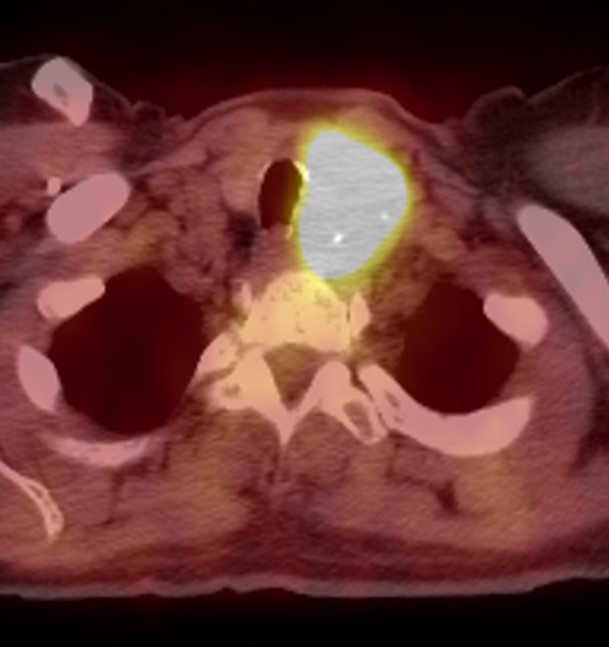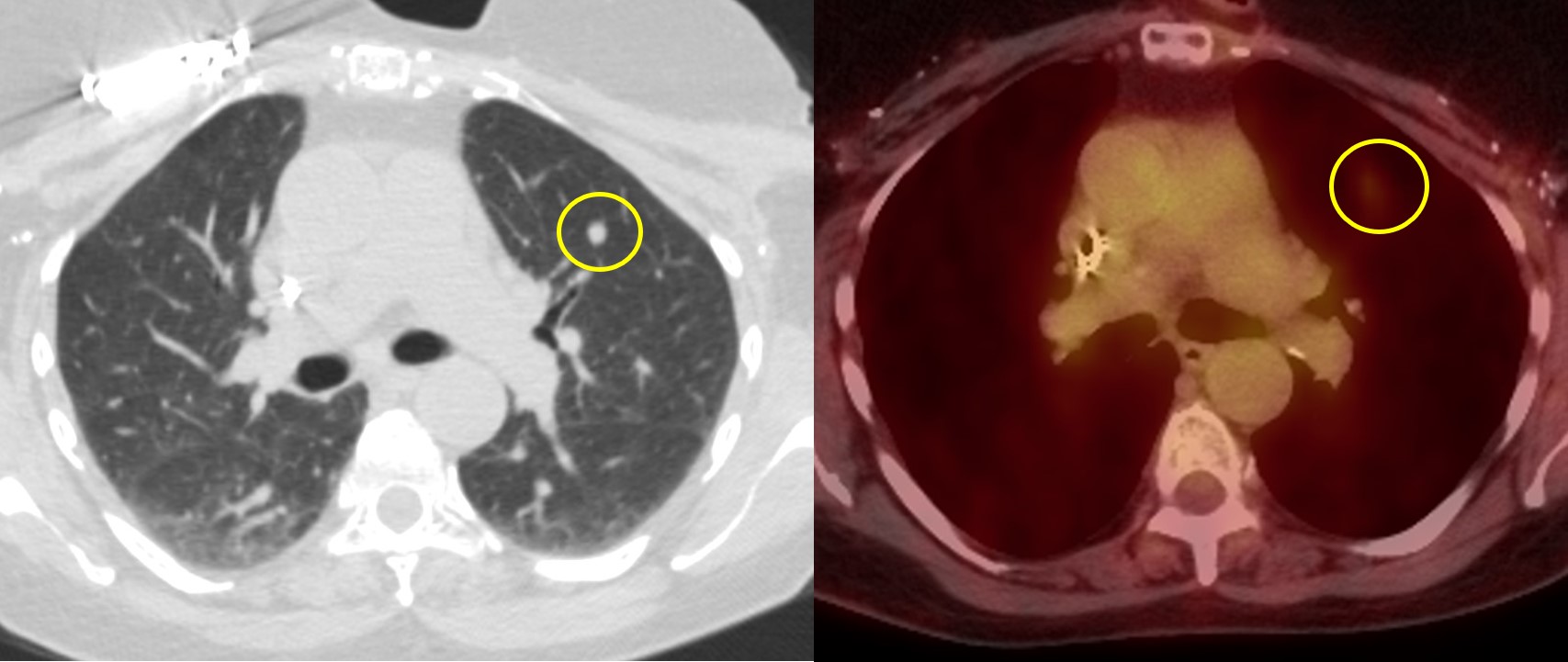[1]
Sipos JA, Mazzaferri EL. Thyroid cancer epidemiology and prognostic variables. Clinical oncology (Royal College of Radiologists (Great Britain)). 2010 Aug:22(6):395-404. doi: 10.1016/j.clon.2010.05.004. Epub 2010 Jun 3
[PubMed PMID: 20627675]
[2]
Nagaiah G, Hossain A, Mooney CJ, Parmentier J, Remick SC. Anaplastic thyroid cancer: a review of epidemiology, pathogenesis, and treatment. Journal of oncology. 2011:2011():542358. doi: 10.1155/2011/542358. Epub 2011 Jun 12
[PubMed PMID: 21772843]
[3]
Dohán O, Carrasco N. Advances in Na(+)/I(-) symporter (NIS) research in the thyroid and beyond. Molecular and cellular endocrinology. 2003 Dec 31:213(1):59-70
[PubMed PMID: 15062574]
Level 3 (low-level) evidence
[4]
Johnson NA, Tublin ME. Postoperative surveillance of differentiated thyroid carcinoma: rationale, techniques, and controversies. Radiology. 2008 Nov:249(2):429-44. doi: 10.1148/radiol.2492071313. Epub
[PubMed PMID: 18936309]
[5]
Marcus C, Whitworth PW, Surasi DS, Pai SI, Subramaniam RM. PET/CT in the management of thyroid cancers. AJR. American journal of roentgenology. 2014 Jun:202(6):1316-29. doi: 10.2214/AJR.13.11673. Epub
[PubMed PMID: 24848831]
[6]
Haugen BR, Alexander EK, Bible KC, Doherty GM, Mandel SJ, Nikiforov YE, Pacini F, Randolph GW, Sawka AM, Schlumberger M, Schuff KG, Sherman SI, Sosa JA, Steward DL, Tuttle RM, Wartofsky L. 2015 American Thyroid Association Management Guidelines for Adult Patients with Thyroid Nodules and Differentiated Thyroid Cancer: The American Thyroid Association Guidelines Task Force on Thyroid Nodules and Differentiated Thyroid Cancer. Thyroid : official journal of the American Thyroid Association. 2016 Jan:26(1):1-133. doi: 10.1089/thy.2015.0020. Epub
[PubMed PMID: 26462967]
[7]
Donohoe KJ, Aloff J, Avram AM, Bennet KG, Giovanella L, Greenspan B, Gulec S, Hassan A, Kloos RT, Solórzano CC, Stack BC Jr, Tulchinsky M, Tuttle RM, Van Nostrand D, Wexler JA. Appropriate Use Criteria for Nuclear Medicine in the Evaluation and Treatment of Differentiated Thyroid Cancer. Journal of nuclear medicine : official publication, Society of Nuclear Medicine. 2020 Mar:61(3):375-396. doi: 10.2967/jnumed.119.240945. Epub
[PubMed PMID: 32123131]
[8]
Lameka K, Farwell MD, Ichise M. Positron Emission Tomography. Handbook of clinical neurology. 2016:135():209-227. doi: 10.1016/B978-0-444-53485-9.00011-8. Epub
[PubMed PMID: 27432667]
[9]
Berry K, Elder D, Kroger L. The Evolving Role of the Medical Radiation Safety Officer. Health physics. 2018 Nov:115(5):628-636. doi: 10.1097/HP.0000000000000949. Epub
[PubMed PMID: 30260854]
[10]
Delbeke D, Coleman RE, Guiberteau MJ, Brown ML, Royal HD, Siegel BA, Townsend DW, Berland LL, Parker JA, Hubner K, Stabin MG, Zubal G, Kachelriess M, Cronin V, Holbrook S. Procedure guideline for tumor imaging with 18F-FDG PET/CT 1.0. Journal of nuclear medicine : official publication, Society of Nuclear Medicine. 2006 May:47(5):885-95
[PubMed PMID: 16644760]
[11]
Leboulleux S, Schroeder PR, Schlumberger M, Ladenson PW. The role of PET in follow-up of patients treated for differentiated epithelial thyroid cancers. Nature clinical practice. Endocrinology & metabolism. 2007 Feb:3(2):112-21
[PubMed PMID: 17237838]
[12]
Treglia G, Muoio B, Giovanella L, Salvatori M. The role of positron emission tomography and positron emission tomography/computed tomography in thyroid tumours: an overview. European archives of oto-rhino-laryngology : official journal of the European Federation of Oto-Rhino-Laryngological Societies (EUFOS) : affiliated with the German Society for Oto-Rhino-Laryngology - Head and Neck Surgery. 2013 May:270(6):1783-7. doi: 10.1007/s00405-012-2205-2. Epub 2012 Oct 2
[PubMed PMID: 23053387]
Level 3 (low-level) evidence
[13]
Archier A, Heimburger C, Guerin C, Morange I, Palazzo FF, Henry JF, Schneegans O, Mundler O, Abdullah AE, Sebag F, Imperiale A, Taïeb D. (18)F-DOPA PET/CT in the diagnosis and localization of persistent medullary thyroid carcinoma. European journal of nuclear medicine and molecular imaging. 2016 Jun:43(6):1027-33. doi: 10.1007/s00259-015-3227-y. Epub 2015 Oct 24
[PubMed PMID: 26497699]
[14]
Beheshti M, Pöcher S, Vali R, Waldenberger P, Broinger G, Nader M, Kohlfürst S, Pirich C, Dralle H, Langsteger W. The value of 18F-DOPA PET-CT in patients with medullary thyroid carcinoma: comparison with 18F-FDG PET-CT. European radiology. 2009 Jun:19(6):1425-34. doi: 10.1007/s00330-008-1280-7. Epub 2009 Jan 21
[PubMed PMID: 19156423]
[15]
Cabanillas ME, McFadden DG, Durante C. Thyroid cancer. Lancet (London, England). 2016 Dec 3:388(10061):2783-2795. doi: 10.1016/S0140-6736(16)30172-6. Epub 2016 May 27
[PubMed PMID: 27240885]
[16]
Piccardo A, Trimboli P, Foppiani L, Treglia G, Ferrarazzo G, Massollo M, Bottoni G, Giovanella L. PET/CT in thyroid nodule and differentiated thyroid cancer patients. The evidence-based state of the art. Reviews in endocrine & metabolic disorders. 2019 Mar:20(1):47-64. doi: 10.1007/s11154-019-09491-2. Epub
[PubMed PMID: 30900067]

